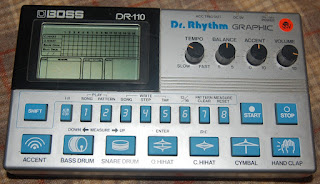
It began, as so many things do, with the innocent notion of exacting a simple task. After having a look at the Alesis units, it occurred to me that a significant portion of the drum machine population here has less than ideal pad response. The idea here was to give a nod to a simple cleaning, and work up from there.

It is my firm belief that opening the case here did not put into motion the sequence of events that spelled doom. Okay, that's a bit over the top, the unit is only on the nuisance list, I didn't smash it with a hammer. Yet.

Another fine example of keeping the analog and logic boards separate, here's the sound production level.

They should have made these in clear enclosures; besides the hand stacking of some caps this thing looks sharp.

So my plan here is to polish the contacts, and wash the conductive rubber buttons with distilled water and coarse paper in hopes that the paper has enough tooth to exfoliate the contact surface of the rubber. As evidenced in the image above, the carbon component of the conductive substrate has leached onto the circuit face, indicating a depletion of conductive particles within the contact patch of the rubber itself, more or less circumventing its ability to act as a switch.
You'll have to forgive me if I'm covering ground that has been trampled to pieces and proven wrong by thousands before me, I'm not a devoted reader of synth DIY lists, and as such am bound to fall into a couple over worn angles.
I digress, the cleaning approach has yet to be proven or disproven, and it looks likely that it will have to wait for either the Alesis, Casio or another Roland unit to be put to test. My intent being not to continue breaking things, naturally.

Incidentally, if you're about to crack the case on your own DR-110 and you wound up here for some encouraging words: watch this power switch button like a hawk. If you're an idiot like me and disassemble it in the living room or other uncontrolled environment, this little blue plastic part may get uppity and travel impressive distances to escape detection.

Imagine this as an animated GIF oscillating between green, blue, yellow and red, and for a moment, before the headache sets in, we can imagine ourselves back in 1999, long before this beast was broken.
So what happened?
Well, I cleaned and polished the bank of switches and put the unit back together. In the past this has always been a battery operated device, but not having a quartet of fresh AA batteries on hand I opted instead to utilize a power supply. I reached for my nice regulated negative tip PSU that I use in lieu of the specified Boss PSA adapter for my PG-300 (so I am pretty fucking sure that polarity is not the issue), plug it in and power it up. Nothing, for a moment, then the distinctive scent of magic smoke.
I don't care how fast you are, even Bruce Lee couldn't unplug something fast enough to avoid damage once the smoke is on parade.

Here's the visible damage (at left) compared to a blow-up of before at right, the trace that was having a go at playing fuse being the likely source of odor. It was still warm after I had grabbed a screw driver and cracked the case.
I notice evidence of someone having been here before, what with the scratching and all. So my immediate suspicion is that something was done here that caused this, and the "fix" wasn't activated until application of DC power years later. This is the safest tack for me to take, as it leaves the most options of actual cause for failure open. I find it generally inadvisable to troubleshoot with too many preconceived notions, as red herring is not my favorite fish.
Beyond taking a picture I haven't done anything with this unit, besides button it back up, plop it in its case and toss it on the to do pile.
As if I needed more stuff on the to-do pile.
Almost forgot: http://www.theninhotline.net/dr110/ for service data..
No comments:
Post a Comment